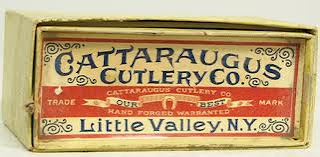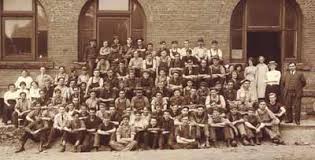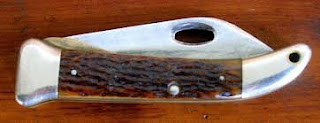iKnife Collector
The online community of knife collectors, A Knife Family Forged in Steel
This was an unscripted freeform chat hosted by Derek Smith And Mike...
Cattaraugus_Cutlery_Company wiki
FRIDAY, JULY 26, 2013
Cattaraugus Cutlery Company
Tags: Cattaraugus, information
Replies to This Discussion
-
Permalink Reply by Jan Carter on August 3, 2014 at 12:57
-
Cattaraugus Bank Connection To Cutlery
There is a great deal of documentation
that Cattaraugus, Case Brother's,
W.R.Case & Son Cutlery's were all
financed by Cattaraugus Bank. John
Russell Jr. himself took out loans
in the 1940's from them.
This is not a widely known fact. -
-
Permalink Reply by Jan Carter on August 3, 2014 at 12:59
-
-
Permalink Reply by Jan Carter on August 3, 2014 at 13:01
-
-
Permalink Reply by Jan Carter on August 3, 2014 at 13:02
-
There is an article on The American Museum of Cutlery in Cattaraugus.It is in the Knives Illustrated magazine June 2008 Volume 22, NO 3.
-
-
Permalink Reply by Jan Carter on August 3, 2014 at 13:05
-
An Introductory History of
The First Rail Road Boomtown
Cattaraugus Village and Rich Valley
The 1779 Battle of Cattaraugus
During the American Revolutionary War, in 1779, General George Washington adopted a strategy of reducing the assets of the British by attacking the American Indian tribe’s villages who sided with them. Nearly all of New York State's Iroquois Indian Tribes fell into that category. Washington sent two of his most trusted soldiers through Pennsylvania into New York State with significant forces, to punish the Seneca Indians both in the Genesee River Valley and also along the Allegany River. Washington chose Col. Daniel Brodhead and General John Sullivan. General Sullivan mounted a campaign against the Seneca Indians in the Genesee Valley totally destroying many Indian villages and crops. The Seneca Indians fled to the Zoar Valley area between Springville and Lake Erie in northern Cattaraugus County just east of Chautauqua, and to Fort Niagara on Lake Ontario; both under British protection. At the same time as Sullivan’s expedition, General Washington sent a force of over 600 men under the command of Col. Daniel Brodhead up the Allegany into Western New York from Pittsburgh to test the resolve of the Seneca’s, as well as the western defenses of the British. The soldiers destroyed many Indian villages and all crops of those tribes loyal to the British as they encountered them. Sullivan and Docksteder had a plan of joining forces and capturing Fort Niagara from the British.
A British force was encamped at the mouth of the Cattaraugus River at present day Sunset Bay under the command of John Docksteder. A Seneca Scout from Chief Cornplanter’s Town in Pennsylvania arrived at Docksteder’s outpost to alert the British of Brodhead's advance. Seneca Indians were well known for their long distance running skills. One or more runners covered this distance of nearly 75 miles in a matter of hours! The British Army force-marched to present day Cattaraugus Village to engage the advancing American Soldiers. Seneca Scouts were key in leading the British force against Revolutionary Soldiers and their Delaware Tribe of Indian scouts within, and just south of, present day Cattaraugus Village. The British further engaged the Revolutionaries at the mouth of Bucktooth Creek (near present day Salamanca, N.Y.) where there were many casualties, all thought to be Delaware Indians. Cattaraugus Village was the northernmost incursion of Brodhead's force into New York State. His defeat at Cattaraugus Village dashed the possibility of joining forces with General Sullivan and attacking Fort Niagara. Col. Daniel Brodhead escaped with the remainder of his force back to Pittsburgh.
Settlement
After the American Revolution, many soldiers were granted tracts of land in the Westfield, Chautauqua County, New York area. This Chautauqua area was of strategic importance in the late 1700’s and early 1800’s. Travelers on the Great Lakes could portage to Chautauqua Lake and then easily travel on to the Allegheny River, the Ohio River, the Mississippi and beyond. It wasn’t until during the War of 1812 that adventuresome pioneers ventured into the region just east of Chautauqua that was known by the Senecas as Cattaraugus (“Cattaraugus” is a Seneca word for “Burning Springs” due to ancient lightning strikes in the natural gas rich banks of the river of the same name).
The earliest recorded death in the Cattaraugus Village area was in 1810 when Captain Rosecrantz, an Indian trader, was found dead of mysterious causes. Then, in 1826, Thomas Dutton another merchant from neighboring Lodi (now Gowanda) traded too much alcohol to the Indians. Local merchants were incensed and bought him out, paying him in gold. As he left Lodi traveling though the northern Cattaraugus wilderness, he was never again seen alive. His body was found the next spring, without his gold or his fancy silver watch. In 1828, Brothers Calvin and Arad Rich courageously relocated their families to the valley and surrounding hills around what is now Cattaraugus Village. The area became well known as Rich Valley, not just for the prolific Richs, but also because of the fertile soil and the year round stream of water that coursed through the valley. The stream dropped well over 100 feet in elevation within a short distance, providing ideal conditions for future water-powered mills.
Boomtown
With the impending completion of the Erie Canal, President Andrew Jackson championed the effort to develop the country’s interior with legislation that he supported. This effort led directly to the planning of a railroad to connect the Hudson River with Lake Erie, traversing through the southern-tier of New York State. When this New York and Erie Railroad was completed in 1851, it wasn’t merely a new railroad. It was the longest rail line in the entire world! It connected Piermont on the Hudson, with Dunkirk on Lake Erie.
In a last minute change in course, in 1849, this railroad came through Rich Valley. The new rail town was not planned as other communities were along the line. It was not settled. It was not founded. It just happened!! The new village was quickly carved out of thick virgin forest. Large crews of men were needed to cut trees, pull stumps, cut rails, construct massive stone culverts and excavate hillsides throughout the area. This involved intense manual labor and skilled stone masons many of whom apprenticed on the Erie Canal construction. Hard drinking Irishmen from County Cork, Ireland dominated the three work crews who were uprooted from other areas and suddenly and unexpectedly sent to set up housekeeping and small businesses next to the railroad tracks being constructed. The “Corkonians” set up their community in an area they called the “Patch” (as in “potato patch”) on the north side of the tracks in the midst of what is now Cattaraugus Village. Some of their names were Carroll, Kelly, Crowley, and McCarthy. The first telegraph line was installed immediately to provide communication facilities between construction crews.
In 1851, when the first train came through carrying President Millard Fillmore, his entire cabinet, and chief of the Seneca Nation, there were few communities in this country more proud than this new Village without a name. (It was referred to as “Albion” on President Fillmore’s rail ticket.) The Village was named “Cattaraugus” by President Millard Fillmore himself, in honor of the name of the County and the fact that the upstart village was already a center of commerce and needed its own post office and depot to serve the most burgeoning economy in the State at that time. The Postmaster General himself was on hand to interview the postmaster candidates. Economic growth intensified due to the new train depot and railroad sidings. Stage lines sprang up connecting Cattaraugus to areas with no rail service. One stage line went to New Albion, Leon, Conewango and on to Jamestown. Another stage line went to Otto, East Otto, Plato, West Valley, Springville and Arcade. Numerous cheese factories were constructed. Lumber, apples, potash, lath, leather, and whiskey (not necessarily in this order) were just a few of several dozen industries. Hotels, boarding houses, livery stables, and schools opened their doors. The town boasted a hospital, doctors, veterinarians, architects, and even a medical college. An important influence on the local economy was due to the fact that the railroad completion made the Erie Canal obsolete. For many years most of our nations western commerce coursed through Cattaraugus Village. Locally produced goods could be available for sale on the streets of New York City, 450 miles away, within 24 hours on any one of the 4 trains a day that came through. Many of the laborers who helped complete this last section of railroad, decided to settle in Cattaraugus. After the construction crews moved on, over 1500 persons lived in the area. By 1860 the township boasted 305 dwellings, 1557 oxen, 383 horses, and 8 school districts with 649 children in school. Cattaraugus Village truly was a railroad boomtown on the way west, and most likely was the very first to fit that description.
Several fires swept through the village over the years. The most damaging was in September 1888. It destroyed nearly the entire business district. Almost all of the buildings in the Village were wood frame prior to 1888. After the fire, the buildings were reconstructed out of brick to reduce the possibility of a recurrence.
Today, visitors can attest to the unique feeling that they experience when discovering Cattaraugus Village. The Village does not have a crossroads. It has a “T”. At the head of that “T” is the old Crawford Hotel (1890). Once the center of activity in the Village and the destination of thousands of salesmen and merchants, this hotel awaits rediscovery as if in suspended animation… still with the original light fixtures, tin ceilings and wall paper.
It is well documented that Abraham Lincoln visited Cattaraugus in 1860. Teddy Roosevelt gave his last speech prior to being elected Governor of New York here in the “Patch” from the back of his Rough Rider Railcar. TR visited again as President. Daniel Webster and Commodore Perry were visitors. President Franklin D. Roosevelt visited here more than once. After Mark Twain visited, he named his housecat “Cattaraugus”.
If you squint your eyes in the evening sunset, you can almost see them all conversing, beverage in hand, on the Hotel porches.
By 1874 the following businesses and trades were long established in Cattaraugus Village:
Agricultural implements
Apples
Architect
Axe Manufacture
Bakery
Bank and Private Banks
Barbers
Blacksmithing
Bookbinder
Boots and Shoes
Brackets and Moldings
Broom Maker
Building Mover
Butter and Cheese Dealer
Butter Tub Manufacturer
Cabinet Making
Carpenter and Joiner
Carpet Weaving
Carriage, Wagon, and Sleigh
Manufacturer
Cattle Dealers
Cheese Box Manufacturer
Cheese Making
Chestnut Harvesting
Churches
Cider Mill
Cigars and Tobacco
Civil Engineer
Clergy
Coal
Constable
Cooperages, Stave Mill
Creamery
Crockery, China, and Glassware
Cutlery -- Knife works and Razor Manufacture
Dairy Apparatus
Dairy Farmer
Dentists and Doctors
Door, Sash, and Blind Manufacturer
Dress and Cloak Making
Druggist
Dry Goods
Eating Houses
Engineer
Express Agents
Fancy Goods
Farming
Fire Company, Cattaraugus Hook and Ladder Co.
Florists
Flour, Feed, and Grain Mill
Fork, Hoe, and Broom Handles
Fur Dealer
Furnishings
Furniture
General Merchant
General Store
Gent's Furnishings
Glue Manufacturer
Grist Mill
Groceries and Provisions
Gunsmith
Hardware
Harness Making
Hoe manufacturer
Hotels (at least 4) and Boarding Houses (several)
Insurance
Justice of the Peace
Ladies Furnishings
Lath and Shingle Manufacturer
Lawyers
Lightning Rods
Lime, Plaster, and Cement
Liveries and Boarding Stables
Livestock Dealer
Logging
Lumber Mills, Dealers, Roller Mills
Marble Works
Masonry
Meat Market and Butchers
Mechanic
Medical College
Mercantile
Milk Pans and Coolers
Millinery
Millwright
Mine Speculators
Molding
Music and Instruments
Newspaper
Oil Speculators
Opera House
Painters
Pastor
Patent Medicine Manufacturer
Patent Right Agent
Peddlers
Photographers
Physician and Surgeon
Picture Framing
Planeing Mill
Postmaster (since 1851)
Potash
Printing
Produce Sales
Railroad (Erie - 1851 completed)
Railroad Agents
Railroad Engineer, Foreman
Real Estate Sales
Restaurants
Saloons
Schools
Seamstress
Sewing Machine Agent
Shoe Maker
Shoe Repair
Sign Painters
Stagecoach Proprietors
Station Agent
Stone Cutting
Stump Pulling
Surveyor
Tailoress
Tannery
Tavern
Tea Rooms
Teamster
Telegraph Company, Telegrapher (since 1849)
Thresher
Tinsmith & Sheet Iron Manufactory
Town Clerk
Town Supervisor
Toys
Trapping
Turning Lathe
Undertaking and Casket Manufacturer
Washing Machine Agent
Watches and Jewelry
Weaver
Well Driving
Whiskey Distilleries (2)
Wood Turning
Cattaraugus Village from 1849 to World War One, was one of the most vibrant and exciting communities in America. Pioneer adventurers transformed a wilderness company town from its beginnings, well into the industrial age. The study of Cattaraugus Village is an object lesson as to what life experiences were involved in developing the character and common fabric of what it meant to be an American. Generous individuals, businesses and governments separately and collectively gave of their fortunes and their time to create an American Dream that remains today as a prime example of what is right with America.
Copyright 2011
Patrick J. Cullen
Cattaraugus, New York
pjcullen1@aol.com
-
Latest Activity
© 2025 Created by Jan Carter.
Powered by
![]()



